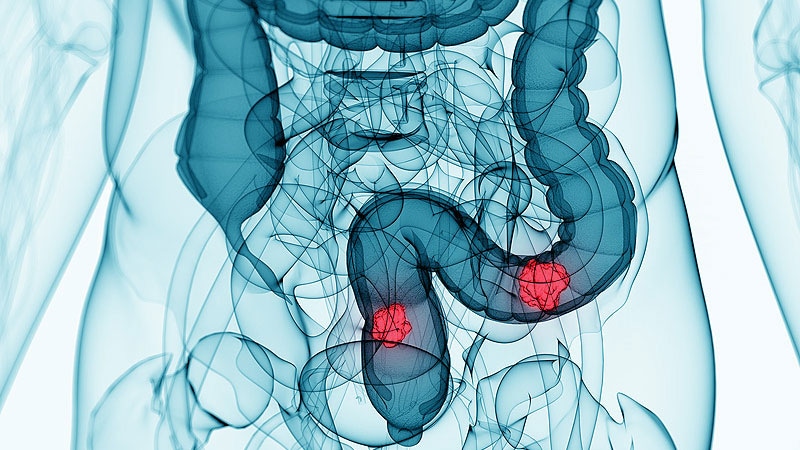Combining an EGFR inhibitor with a pair of checkpoint inhibitors can produce “promising” activity in certain patients with colorectal cancer (CRC), according to an investigator from a phase 2 trial.
The trial was designed to test the combination of panitumumab, ipilimumab, and nivolumab in patients with previously treated, unresectable and/or metastatic, microsatellite stable or mismatch repair–proficient CRC without mutations in KRAS, NRAS, or BRAF.
Among 49 evaluable patients treated with the triplet, 35% had a partial response at 12 weeks of follow-up, which met the trial’s primary response endpoint, according to investigator Michael S. Lee, MD, of the University of Texas MD Anderson Cancer Center in Houston.
“Though toxicities were, of course, observed, they were consistent overall with the expected adverse event profiles of anti-EGFR therapy and combination ipilimumab and nivolumab. Correlative studies are ongoing to identify potential biomarkers of response,” Lee said when presenting the trial results at the 2021 Gastrointestinal Cancers Symposium (Abstract 7).
Immune activation?
The rationale for adding panitumumab to immune checkpoint inhibitors comes, in part, from a trial published in 2014 in The Lancet Oncology. The trial showed that panitumumab was noninferior to cetuximab. Panitumumab was associated with a 22% response rate in patients with KRAS wild-type, metastatic CRC that was refractory to chemotherapy. Progression-free survival (PFS) and overall survival (OS) were similar between the treatment arms.
In addition, in mouse models of RAS wild-type CRC, treatment with an anti-EGFR antibody induced immunogenic cell death.
“Moreover, translational studies of tumor biopsies from patients who were treated with the anti-EGFR antibody cetuximab showed that responders had significant increases in T-cell infiltration and cytolytic activity within tumors after starting treatment,” Lee said.
In the latter studies, tumor samples taken at the time of disease progression also showed increased expression of immune checkpoint inhibitor pathways, including PD-L1, the primary target of nivolumab, and CTLA-4, the primary target of ipilimumab.
“Given this, we hypothesized that combining anti–PD-1 and anti–CTLA-4 antibodies with anti-EGFR therapy would be synergistic,” Lee said.
Single-arm study
Investigators enrolled patients with unresectable and/or metastatic CRC in the trial. All patients had disease that was KRAS, NRAS, and BRAF wild-type, and they had either microsatellite stability or proficient mismatch repair. Patients also had to have received one or two prior lines of therapy, not including an anti-EGFR agent.
The patients received panitumumab at 6 mg/kg IV every 2 weeks, nivolumab at 240 mg IV every 2 weeks, and ipilimumab at 1 mg/kg IV every 6 weeks.
Of all 56 patients enrolled, 28 (50%) had tumors in the left colon, 3 (5%) had tumors in the right colon, 2 (4%) had tumors in the transverse colon, 16 (29%) had rectal tumors, and 7 (13%) were not specified.
As noted before, 49 patients were evaluable, and the trial met its primary endpoint of responses in at least 17 patients (35%) at 12 weeks. All were partial responses.
Of the remaining patients, 21 (43%) had stable disease, and 11 (22%) had disease progression. Of the latter group, five patients did not have documented radiographic progression at 12 weeks, but they discontinued therapy before restaging because of unequivocal clinical progression.
The best response rate (confirmed and unconfirmed) at any time was 41%.
At a median follow-up of 12.1 months, the median PFS was 5.7 months. The OS data were not mature at the time of data cutoff. However, the median OS was 27 months.
There were two deaths on study, one from myocarditis possibly related to the study treatment, and one from colonic perforation, which was deemed unlikely to be treatment related.
Grade 3 or 4 adverse events included hypomagnesemia (n = 6), acneiform rash (n = 6), increased lipase (n = 5), increased amylase (n = 4), alanine aminotransferase elevation (n = 3), aspartate aminotransferase elevation (n = 3), diarrhea (n = 3), hyophosphatemia (n = 3), and maculopapular rash (n = 3).
‘Disappointing PFS’
In the question and answer session following the presentation, moderator Michael J. Hall, MD, of Fox Chase Cancer Center in Philadelphia, asked whether the response rate seen with the addition of panitumumab was what the investigators expected, independent of the dual–checkpoint inhibitor therapy, and “with the relatively disappointing PFS you saw, what are the plans moving forward with this regimen?”
“These are great questions and thoughts I’ve had as well,” Lee replied.
He noted that studies of other anti-EGFR and checkpoint inhibitor combinations have had relatively low response rates, and his group’s study was conducted with “an effort to try and get over this immune-cold environment that we know exists in the tumor microenvironment,” he said.
Lee also acknowledged that the response rate may have been slightly higher than that seen in other studies because of the preponderance of left colon tumors, which are generally more amenable to systemic therapy.
Regarding PFS, Lee said the analyses of durability of response are still ongoing, and the median PFS was better than that seen in a trial of single-agent panitumumab in a similar population.
The current study was funded by Amgen and Bristol Myers Squibb. Lee disclosed institutional research funding from the companies, consulting/advising for Pfizer, and travel expenses from Genentech/Roche. Hall disclosed relationships with Ambry Genetics, AstraZeneca, Caris Life Sciences, Foundation Medicine, InVitae, and Myriad Genetics. He also shares a patent with several Fox Chase investigators for a novel method to investigate hereditary CRC genes.
The Gastrointestinal Cancers Symposium is sponsored by the American Gastroenterological Association, the American Society for Clinical Oncology, the American Society for Radiation Oncology, and the Society of Surgical Oncology.
This article originally appeared on MDedge.com, part of the Medscape Professional Network.
